Facing express fast bowlers must be among the most dreaded tasks for any batsman. A genuine fast bowler who can bowl consistently at or above 145 km/h (~90 mph) can be a great asset for any team, as such bowlers can exploit even a dead surface. But, how can you increase your pace and what should you do (or not do) to bowl fast in cricket?
To bowl fast in cricket, you need to have a comfortable long run-up, proper hip-shoulder separation, and other technical abilities such as a stable wrist position, proper bowling action, and synchronization between bowling and non-bowling arms. Good fitness and flexibility is also crucial to bowl fast.
There are numerous other small and big factors involved in fast bowling, and you can bowl fast consistently only if you execute them well. In this article, we will take a detailed look at what those factors are, and how you can master them! Plus, I’ll also share some secrets of bowling faster in Cricket!
What is the Role of a Fast Bowler in Cricket?
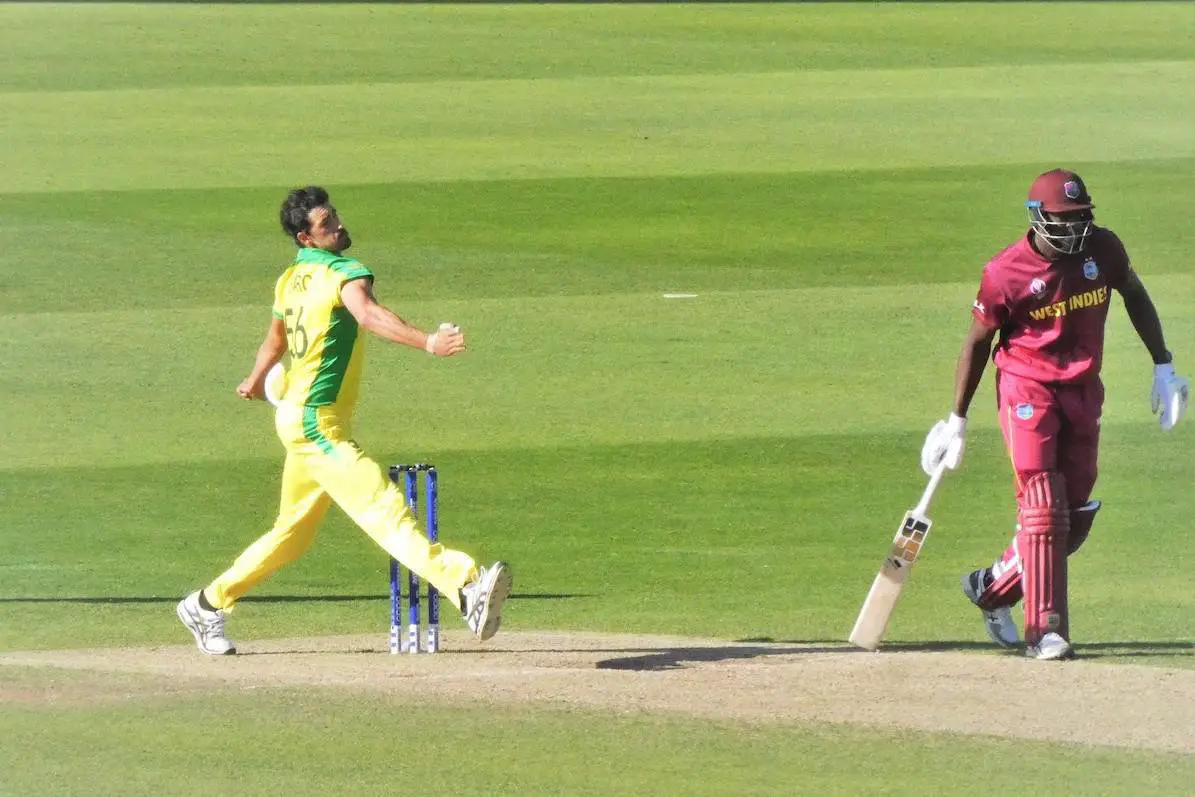
In a cricket team, the bowling unit generally comprises two categories of bowlers, spin bowlers, and fast bowlers also called pacers.
Each of the categories of bowlers has specific roles and they are brought into the action depending on the phase and requirement of the game. For instance, fast bowlers generally open the bowling attack.
The spinners generally don’t get much turn early on with the new ball. While some captains try to add an element of surprise by opening the bowling with a spinner, you will almost always see the pacers getting the initial few overs.
The key role of a fast bowler is to provide the team early wickets so that the spinners or other bowlers can capitalize on it. Early wickets also help the team and fellow fast bowlers as it brings batting side’s middle-order batsmen early in the game.
Restricting runs, breaking partnerships in their subsequent bowling spells are among other expectations from the pacers. The pacers are most preferred bowlers during the death overs in the limited over games.
With pace along with accuracy, it becomes difficult to score the runs against pacers. In addition to pace, fast bowlers’ abilities to swing or seam the ball or generate extra bounce make the more dangerous and at times unplayable.
Tips on How to Bowl Faster in Cricket
If you are to study the science and refer to “The Biomechanics of Fast Bowling“, a bowler’s basic action or the sequence can be divided into five segments: The run-up, Pre-delivery stride, Delivery stride, Ball release and Follow through.

The correct execution of the sequence will help the bowler to deliver the ball with the desired speed and swing. I am sure, the following tips will improve your execution and increase your pace with better control.
Tip 1 – Fix your Starting Point of the Run-up
Starting the run-up from the same position is the basis of fast bowling, and it is followed by all the professional pacers. How to achieve it? Well, it’s simple. Have a mock run-up and just count the number of steps you take as you approach the crease. But before you count or freeze your run-up you should practice a few deliveries of the same or different kinds.
Once you feel you can comfortably deliver balls without any sort of impact on your bowling, you can fix your run-ups length and mark your starting position. The run-up should be measured from your starting location to the crease line.
With the measured steps, your consistency in run-ups can strengthen your muscle memory for your delivery, which means the complete bowling action can be accomplished more smoothly, more accurately, and faster. While playing in a match, you should mark your starting spot on both ends of the field.
Tip 2 – Perfect your Routine before Winding Up to Deliver the Ball
While practicing your run-up, ascertain that you have the most natural and comfortable foot bounding to get a proper landing at the time of release.
Remember the following points before moving to Tip-3.
- In the bound, the right height will provide momentum and contribute to the pace of the delivery.
- Too high bound can disrupt the momentum and it will slow the bowling speed.
- Without the bound, you won’t get the power required to deliver a fast ball.
- It will help if you practice a moderate jump before delivery.
Tip 4 – Pay Special attention to Front Foot Landing
Towards the end of the bound, as you land on your back foot first, try to keep your weight in your toes and then transfer the weight to your front foot swiftly.
Your front toe should point toward the batsman as your hips spin around. As you release the ball, ensure that your front leg remains fully straight rather than being bent at the knees shown in the image below.
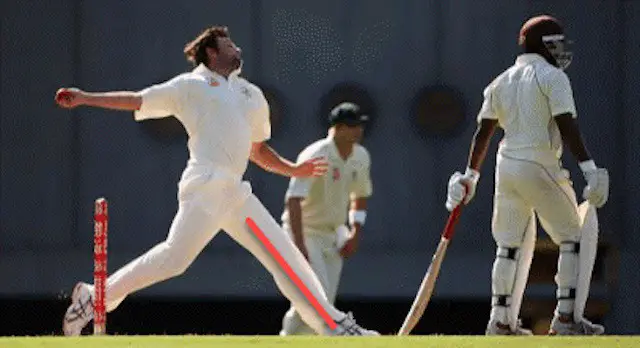
Such “braced” leg position acts as a pivot point and helps a bowler to generate power by forcing the lower part of the body to decelerate very quickly, while the upper body is accelerated forward.
It is akin to the sudden break applied to a speeding car, which results in decelerating the car, but the passengers get the forward acceleration.
Tip 4 – Practice your Run-up
Once you are done with fixing the starting point of your run-up, the bound, its height, and the foot landing, all you need to do is practice them regularly to solidify your muscle memory.
You will get the right momentum from your run-up, while the leap and the landing should be such that the momentum is not reduced or lost.
Practicing over and over is the key to have the perfect run-up, bound, and landing which together can contribute to the higher speed.
Tip 5 – Make Use of your Front Arm Too
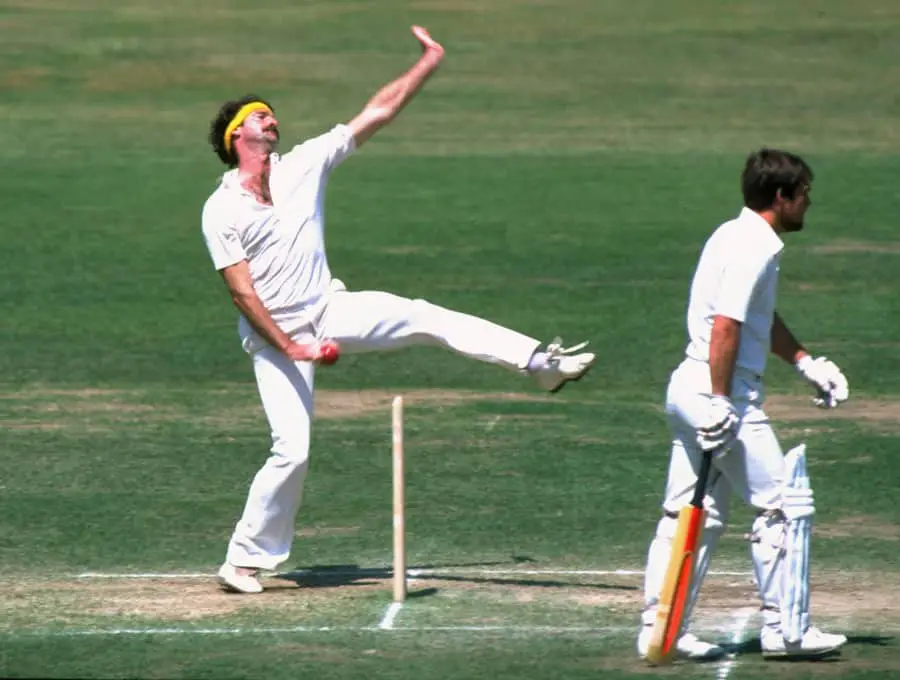
As a fast bowler, you should use the front arm more effectively at the time of pre-delivery stride and the delivery stride. The front arm acts as a lever and pulls the rest of the upper body at the time of release.
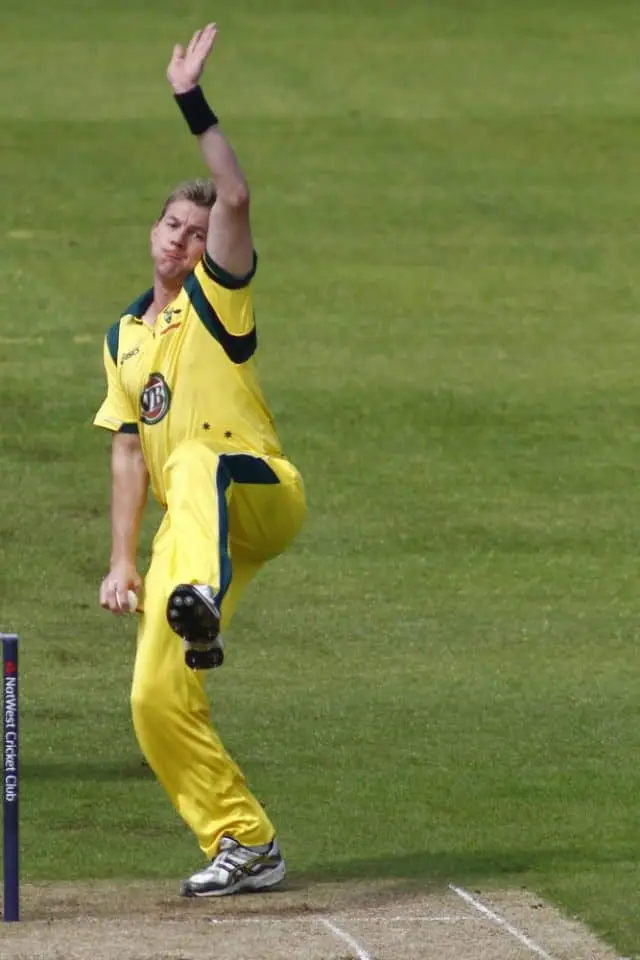
Remember, don’t pull the front arm down too early.
While you bowl, the front arm and bowling arm should be in synchronization. If the front arm is pulled down too early, it means there is no close synchronization between the arms, as a result, some of the energy generated is lost.
The trick lies in extending the non-bowling arm high into the air at the time of landing of the back foot.
Check out this bowling action of Brett Lee and see ‘when’ (playtime at 0:14s) he raised his arm during his stride.
Tip 7 – Focus on Hip and Shoulder Separation
Hip and shoulder separation is one of the most important aspects of gaining speed during fast bowling. The separation is basically creating a difference in the angle between upper and lower body parts, causing a stretch in your muscles as you move through your fast bowling action.
The split second when the upper and lower body separates has a huge role to play in the bowling with extra pace. It is important to note that when we say hip and shoulder, we are talking about the ones on the bowling side of the bowler.
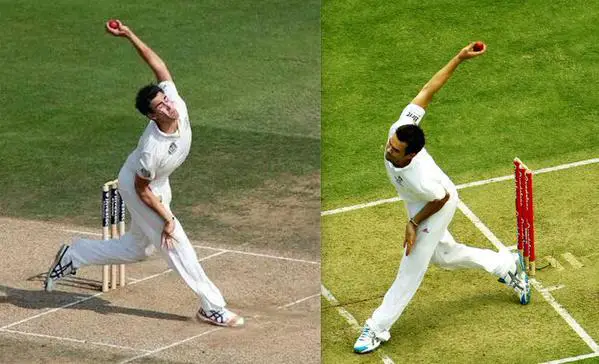
Mitchell Starc and James Anderson demonstrating hip and shoulder separation. Image Credit
During fast bowling, the muscles act like elastic bands tied together. The more elasticity they have the more pace you will generate as a fast bowler.
If you observe some of the dreaded fast bowlers, you will that have more elasticity and the hip and shoulder separation happens pretty fast. To improve the power or pace in bowling the extended and fast hip and shoulder separation proves vital.
Here’s a small drill you can do to practice for hip and shoulder separation.
Wall Drill for hip and shoulder separation.
Tip 8 – Work on Your Bowling Grip
Having the right grip allows the fast bowler to release the ball perfectly. Factors such as pace, swing in the air, or deviation off the pitch depend largely on the grip.
How to Grip the Ball for Fast Bowling?

The index and middle fingers of your hand should be put alongside, and parallel with the seam as shown below. The thumb underneath will support the ball, and it should be resting either close to or on the seam.
Also, have a small gap, generally of a finger’s width in between the palm of your hand and the back of the ball as shown in the image below. Without the gap, it will be difficult for the ball to roll out of your fingers, while too much gap will mean less control over the ball.
Depending on the type of swing you want to induce in the delivery, you may have to change your grip and hence the fingers position on the ball. Check out my other article to know about swinging the ball and the grip variations.
Tip 9 – Work on your Wrist Position
As a fast bowler, you should have the firm wrist position directly behind the ball while bowling. It will increase your chance to get a nice vertical seam position when the ball travels through the air. Also, the solid wrist position is needed to maintain the momentum gained through the run-up. For the solid and stable grip, have your wrist positioned straight, and locked in that desired central position during your entire run-up. You can have your arms movement, but the wrist should remain fixed for better control, pace, and swing.
Tip 10 – Focus on Consistent and Extended Follow-through
Follow-through is the last part of the bowling sequence, occurring after the release of the ball.
The sequence of images in the figure below shows the run-up, the pre-delivery stride, the delivery stride, and eventually the follow-through, overall following the linear path.
Observe that the first stride of the follow-through is also aligned with the intended target (the line of the delivery).
Following a linear path in the entire bowling, sequence reduces the chance of injury and boosts the pace.
For a great follow-through, have your back leg pushed through the crease, while the front leg is pulled out of the crease, and continue the movement down the pitch. This will help you in maintaining the momentum generated during the run-up.
Tip 11 – Record yourself or have a Coach Analyze your Technique
For evaluating your own bowling action and analyzing your bowling style, try recording your entire bowling action right from the starting point of the run-up. You can take the help of your friend or family members if needed to record the video with a cell phone or a video recorder.
With the recordings of your own bowling action, you can check yourself the linear alignment from the run-up till the release of the ball, also the follow-through can be closely analyzed for the alignment issue.
Record several deliveries for better analysis and evaluation of your form. You can also share the recording with your coaches so they can share their offline remarks on your bowling action.
If required, try to make the changes in the action, record again, and then compare the changes and see if there are any improvements.
Tip 12 – Work on Body Flexibility
For fast bowling, your body has to be flexible to be able to accomplish each step of the bowling sequence with perfection. Also, if you want to play for a long time, flexibility is the key. To start with, you should focus on stretching. When we stretch, actually we are warming up and elongating the muscles to prepare them for physical activity.
Dynamic Stretching
Dynamic stretches are done by all kinds of athletes, not just cricketers before every game. In dynamic stretches, you do active movements, where joints and muscles go through a full range of motion. They can be used to help warm up your body before exercising. Check out the below video for dynamic stretching exercises.
Dynamic stretching exercises.
Tip 13 – Work on full-body Strength Training
To bowl fast in cricket, the most basic asset you should possess is the core strength. As you attain maturity age and the body is full-grown, you need to work harder and employ specific strength training programs. Focus on the following key areas during the training:
Upper body
Focus on the core and the shoulders. For more pace in the fast bowling, a strong and stable core is extremely helpful. The core muscles provide stability during the movement and allow a smooth transfer of force. By strengthening the shoulder and its surrounding muscles, you can increase the stability and avoid injury.
Lower body
Of course, having strong legs is equally important. Having a strong lower body is especially important while bowling on heavily worn pitches, or bowling into a stiff breeze.
I also wrote a detailed article on the exercise that you should do before and after the bowling in cricket so that you do not get injured. Do give it a read!
Tip 14 – Practice Bowling Consistently at the Same Spot with High Speed
The most common issue with fast bowlers is consistency. Even after constantly bowling at a higher pace of 145 km/h (90 mph) or more, you can still go for plenty of runs if the bowling lacks good line and length. My advice here is to work in the nets and try pitching the ball constantly at the same spot at the same speed. This will help you with better control in a match.
Tip 15 – Don’t Bowl Too Much (Allow your Body to Recover)
For fast bowling, fitness is paramount. To maintain a good fitness level and avoid muscle or joint injuries, the fast bowler should get sufficient breaks or the recovery period before he can bowl again.
As per The England and Wales Cricket Board (ECB) guidelines, in any seven-day period, a fast bowler should not bowl more than four days in that period and for a maximum of two days in a row.
The rest days can be utilized by analyzing your own or others’ blowing videos or even trying to learn a few batting tricks.
Who are Some of the Fastest Bowlers in Cricket?
It is inevitable to wind up with the names of the fastest bowlers in cricket history. Here are the top five fastest bowlers in the order of their top speed.
1. Shoaib Akhtar (Fasted ball 161.3km/h)
Shoaib Akhtar (Pakistan) is the fastest bowler in the history of cricket. He set the world record by bowling at 161.3km/h (100.2mph) against England in ICC World Cup 2003.
2. Shaun Tait
Shaun Tait (Australia) bowled his fastest delivery of 161.1km/h (100.1 mph) against England.
3. Brett Lee
Former Australia pacer Brett Lee took 310 Tests, 280 ODI, and 487 first-class wickets. He bowled his fastest delivery of 161.1km/h (100.1 mph) against New Zealand in 2005.
4. Jeff Thomson
Jeff Thomson, once again an Australian fast bowler made it to the top-five. His top speed is 160.6km/h (99.79 mph).
5. Mitchell Starc
Yet another Australian, left-arm pacer Mitchell Starc recorded his top speed of 160.4km/h (99.67 mph).
6. Andy Roberts
Sir Andy Roberts, former West Indian fast bowler, bowled his fastest ball at 159.5km/h (99.11 mph).
Final Thoughts
Fast bowling is neither a piece of cake nor rocket science. It needs precise run-up aligned with the perfect delivery stride and the required follow-through.
One should work intensely on the fitness, wrist position, the foot landing, and the movements of hips and arms. Having said that, if you are ready to put in efforts and follow all the tips, success is guaranteed. Do not forget to take the recommended rest between two spells or two matches if you want to bowl for a long time.
To bowl fast, go slow and have patience and work on technique and fitness.
